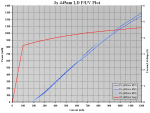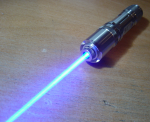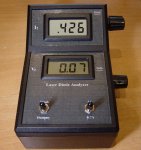IgorT
0
- Joined
- Oct 24, 2007
- Messages
- 4,177
- Points
- 0
I heard there was a lack of PIV plots for these new diodes...
As it happens, i just made a triple plot yesterday.
EDIT: The diodes came from an A130 projector, if it makes any difference at all....
This was actually the first time i had to switch my faithfull OmniDrive Diode Analyzer (TM) into the high current range (2A as opposed to 700mA in the low range) :evil:
A pic of the Diode Analyzer is in the third attachment for those who haven't seen it yet (heard there's a lot of new members)...
I set the Imax to 1.2A and plotted in 100mA resolution. It's actually a higher resolution than 40mA for an 8x or a 12x diode, relativelly speaking.
It would still show if there were any kinks and a higher resolution was required...
The reason i decided to limit the max current to 1.2A is that the Nichia datasheet that is suspected to belong to this diode model only in a different can, mentions 1.2A as the absolute maximum current, and i didn't want to cause any damage to them (prematurelly).
Here's what the diodes look like when plotted using a 405-G-1 broadband lens:

Two diodes (#01 & #03 had almost identical slope efficiency as you can see from the overlapping curves..
I only used one Vf curve so as not to make the graph confusing - it's about at the average Vf i found....
One thing that became immediatelly apparent was that they don't form straight lines like 405nm diodes do. The slope starts slower, then it "speeds up" somewhat, until at a certain point the efficiency starts dropping off, probably from the diode's sensitivity to heat (similar effect as with reds, only less pronounced)...
Except for the slight curvature changes in the plots there were no kinks anywhere and the diodes took the testing quite nicelly.
It is probably safe to say that the majority of these 445nm diodes will fall into approximately the same range displayed here, unless you stumble on a freak or a weakling, so this triple plot should give you an approximate idea of what power to expect at different currents....
I also wanted to take this opportunity to show off my first 445nm laser.

It's in this wicked little stainless steel AA host wearing a 405-G-1 broadband coated lens...
I know most are being made in 18650 hosts but the build here is no crueler (to the battery) than making a keychain 8x laser (which a couple of members did)... Heat is apparently not a problem for it but i'll try in an aluminum host of the same model to see if there is any difference in power stability...
The beast delivers 1190 mW from 1A of current when cold! :evil:
And it's awesome, as those of you who already have a 445nm laser know...
P.S. Many thanks to Jayrob, who keeps making prototype heatsinks for me, regardless of how badly i annoy him with the details... :angel:
As it happens, i just made a triple plot yesterday.
EDIT: The diodes came from an A130 projector, if it makes any difference at all....
This was actually the first time i had to switch my faithfull OmniDrive Diode Analyzer (TM) into the high current range (2A as opposed to 700mA in the low range) :evil:
A pic of the Diode Analyzer is in the third attachment for those who haven't seen it yet (heard there's a lot of new members)...
I set the Imax to 1.2A and plotted in 100mA resolution. It's actually a higher resolution than 40mA for an 8x or a 12x diode, relativelly speaking.
It would still show if there were any kinks and a higher resolution was required...
The reason i decided to limit the max current to 1.2A is that the Nichia datasheet that is suspected to belong to this diode model only in a different can, mentions 1.2A as the absolute maximum current, and i didn't want to cause any damage to them (prematurelly).
Here's what the diodes look like when plotted using a 405-G-1 broadband lens:
Two diodes (#01 & #03 had almost identical slope efficiency as you can see from the overlapping curves..
I only used one Vf curve so as not to make the graph confusing - it's about at the average Vf i found....
One thing that became immediatelly apparent was that they don't form straight lines like 405nm diodes do. The slope starts slower, then it "speeds up" somewhat, until at a certain point the efficiency starts dropping off, probably from the diode's sensitivity to heat (similar effect as with reds, only less pronounced)...
Except for the slight curvature changes in the plots there were no kinks anywhere and the diodes took the testing quite nicelly.
It is probably safe to say that the majority of these 445nm diodes will fall into approximately the same range displayed here, unless you stumble on a freak or a weakling, so this triple plot should give you an approximate idea of what power to expect at different currents....
I also wanted to take this opportunity to show off my first 445nm laser.
It's in this wicked little stainless steel AA host wearing a 405-G-1 broadband coated lens...
I know most are being made in 18650 hosts but the build here is no crueler (to the battery) than making a keychain 8x laser (which a couple of members did)... Heat is apparently not a problem for it but i'll try in an aluminum host of the same model to see if there is any difference in power stability...
The beast delivers 1190 mW from 1A of current when cold! :evil:
And it's awesome, as those of you who already have a 445nm laser know...
P.S. Many thanks to Jayrob, who keeps making prototype heatsinks for me, regardless of how badly i annoy him with the details... :angel:
Attachments
Last edited:








